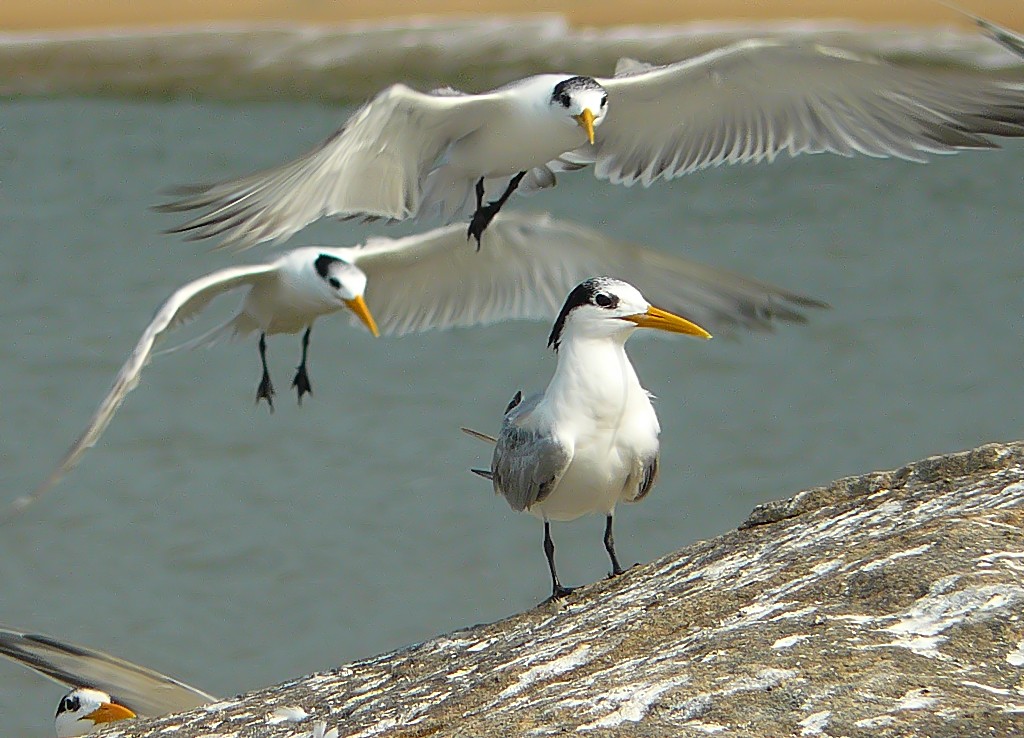Lesser Crested Tern
A species of Crested terns Scientific name : Thalasseus bengalensis Genus : Crested terns
Lesser Crested Tern, A species of Crested terns
Botanical name: Thalasseus bengalensis
Genus: Crested terns
Content
Description General Info
 Photo By OneSandwichAmongLesserCrestedTerns.jpg , used under CC-BY-2.0 /Cropped and compressed from original
Photo By OneSandwichAmongLesserCrestedTerns.jpg , used under CC-BY-2.0 /Cropped and compressed from original Description
Like all Thalasseus terns, lesser crested tern feeds by plunge-diving for fish, usually from saline environments. It usually dives directly, and not from the "stepped-hover" favoured by Arctic tern. The offering of fish by the male to the female is part of the courtship display. This is a medium-large tern, very similar in size and general appearance to its three very close relatives Sandwich tern, Elegant tern and Chinese crested tern. The summer adult has a black cap, black legs and a long sharp orange bill. The upperwings, rump and central tail feathers are grey and the underparts white. The primary flight feathers darken during the summer. In winter, the forehead becomes white. The call is a loud grating noise like Sandwich tern. The grey rump is a useful flight identification feature distinguishing it from the related species. The Elegant tern also differs in a slightly longer, slenderer bill, while Chinese crested tern differs in a black tip to the bill and Sandwich tern a black bill with a yellow tip. Juvenile lesser crested terns resemble same-age Sandwich terns, but with a yellow-orange bill, and paler overall, with only faint dark crescents on the mantle feathers. There are two other orange-billed terns within the range of this species, royal tern and Greater crested tern. Both are much larger and stouter-billed; royal also has a white rump and tail, while crested (which shares the grey rump) is darker overall above and has a yellower bill. See also orange-billed tern. 
Size
43 cm
Nest Placement
Ground
Feeding Habits
Lesser Crested Tern consumes mainly fish and shrimp, diving from 5 meters to snatch prey, often in mixed flocks. Unique dietary trait: lesser Crested Tern selects smaller prey compared to similar species and experiences food theft by gulls.
Habitat
The lesser Crested Tern primarily inhabits coastal environments, favoring low-lying sandy and coral islands for breeding. It is a pelagic bird often found in surf zones and offshore waters. Migration patterns of the lesser Crested Tern typically follow coastlines where they rest on beaches and visit estuaries.
Dite type
Piscivorous
General Info
Feeding Habits
Bird food type
Distribution Area
It breeds in subtropical coastal parts of the world mainly from the Red Sea across the Indian Ocean to the western Pacific, and Australia, with a significant population on the southern coast of the Mediterranean on two islands off the Libyan coast. Accidental breeding has also been reported in Italy and France. The Australian birds are probably sedentary, but other populations are migratory, wintering south to South Africa. 
Species Status
T. bengalensis is one of the species to which the Agreement on the Conservation of African-Eurasian Migratory Waterbirds (AEWA) applies, and one of 10 marine bird species listed in Mediterranean marine birds Action Plan. In India the Lesser crested tern is protected in the PM Sayeed Marine Birds Conservation Reserve. 

 Photo By OneSandwichAmongLesserCrestedTerns.jpg , used under CC-BY-2.0 /Cropped and compressed from original
Photo By OneSandwichAmongLesserCrestedTerns.jpg , used under CC-BY-2.0 /Cropped and compressed from original Scientific Classification
Phylum
Chordates Class
Birds Order
Shorebirds Family
Gulls Genus
Crested terns Species
Lesser Crested Tern